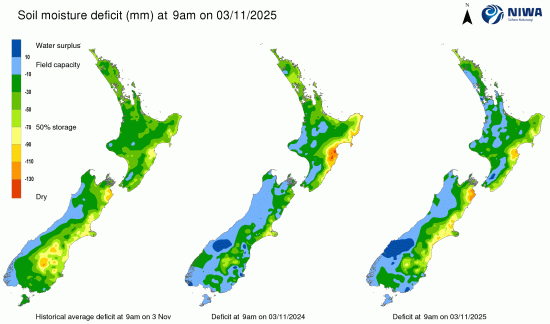
Here's our summary of key economic events overnight that affect New Zealand, with news the week is ending with the 'fear' levels not as strong as earlier in the week - unless you hold cryptos.
First, there were a set of early 'flash' PMIs out for some major economies and there were generally positive. In the US, the S&P Global factory PMI dipped but is still reporting an expansion (51.9). Their services sector expanded faster to a moderate level (55.0), and this was better than expected. Of concern however is that these surveys report input cost inflation accelerated sharply in November, hitting its fastest rate for three years. Of course, tariff-taxes were the predominant reason cited. It seems unlikely there would be the expected rate cut on December 11 (NZT) when the Fed next meets. But one important Fed member does still see a cut possibility.
Business activity might be expanding, but American consumer sentiment as measured by the University of Michigan survey confirms it is now at record lows. The final November survey reports consumers are very frustrated about the persistence of high prices and weakening incomes. The spoils of expansion and success are accruing to a very few which is building a toxic divide.
Canada reported that its October retail sales activity was little-changed from September, which itself was soft. That means their retail sales remained +3.4% higher than year-ago levels.
The Canadian senior loan officer survey reports lending conditions in Q4-2025 are tighter than they were a year ago, but have started to ease.
Japanese exports came in stronger in October than expected, up +3.6% from a year ago when a +1% rise was anticipated. That dovetails into a better than expected 'flash' November factory PMI for Japan - but it isn't yet quite at the expansion level. But their 'flash' services PMI certainly is and it expanded faster in October than expected.
And the Bank of Japan is close to raising their policy interest rate above the current 0.5% when they next meet on December 18, 2025. If not then, then in the January meeting.
In India, their very strong expansion eased in November, but only slightly and is still rocketing along at a very fast pace in both their services and factory sectors. But of note here is that price pressures are easing.
China reported that its foreign direct investment inflows were still struggling in October, but were at least positive in the month. They rose marginally more in the October 2025 month than in the weak October 2024 month. For 2025 so far, these flows are still -10% lower that the same period last year.
In the EU, their November PMIs were positive, with their factory sector's contraction almost ending, and their services sector in a moderate expansion. They will be pleased with these indicators.
Australia is bracing for a Trump lashing, a la Canada. He is likely to claim Australian internet laws designed to protect Australians are an interference in Big Tech's 'free speech'. That they have DEI laws that offend American Christian Nationalists (a crime in his eyes, apparently). And likely to move against Australian lamb and wine exports, even steel and aluminium that is produced not using fossil fuels.
The UST 10yr yield is now at 4.07%, down -4 bps from this time Friday, down -7 bps for the week. The key 2-10 yield curve is still at +55 bps. Their 1-5 curve is flat and the 3 mth-10yr curve is now +13 bps positive. The China 10 year bond rate is up +1 bp at 1.82%. The Australian 10 year bond yield starts today at 4.46%, down -1 bp from Friday, down -2 bps for the week. The NZ Government 10 year bond rate starts today at 4.31%, up +3 bps from Friday, up +12 bps for the week.
Wall Street is ending today with the S&P500 up +1.7% in a recovery mode. If it ends here it will be down a net -0.9% for the week. Here is the Wall Street earnings update. Overnight, European markets were little-changed except Frankfurt gave back what it rose on Thursday. Yesterday, Tokyo closed is Friday session down -2.4% for a -3.3% weekly retreat. Hong Kong also fell -2.4% on Friday for a -4.6% weekly drop. Shanghai fell its own -2.5% on Friday for a weekly retreat of -3.9%. Singapore was down -0.9% on Friday. The ASX200 was down -1.6% in its Friday trade to cap a -2.2% weekly fall. And the NZX50 dipped a minor -0.1% ending its week down -0.3% and the least-worst result of all the markets we follow.
The Fear & Greed index is still in the 'extreme fear' zone as it was last week.
The price of gold will start today at US$4084/oz, and up +US$29 from this time yesterday. But down -US$14 for the week.
American oil prices have softened another -US$1 from yesterday to be just under US$58/bbl, with the international Brent price down under US$62.50/bbl. These are both down -US$2 for the week.
The Kiwi dollar is now at just on 56.1 USc, and up +10 bps from yesterday but down -70 bps for the week. So far in November it has devalued by -2.3%. Against the Aussie we are up +10 bps at 86.9 AUc. Against the euro we are up +20 bps at 48.8 euro cents. That all means our TWI-5 starts today at just over 60.8, up +10 bps from yesterday, but down -50 bps for the week.
The bitcoin price starts today at US$84,617 and down another -3.5% from yesterday. A week ago it was at US$95,780 so it is down -11.7% since then.. Volatility over the past 24 hours has been very high at just on +/- 4.3%.
Daily exchange rates
Select chart tabs
The easiest place to stay up with event risk is by following our Economic Calendar here ».


We welcome your comments below. If you are not already registered, please register to comment.
Remember we welcome robust, respectful and insightful debate. We don't welcome abusive or defamatory comments and will de-register those repeatedly making such comments. Our current comment policy is here.